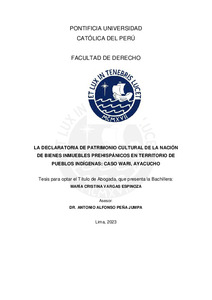| dc.contributor.advisor | Peña Jumpa, Antonio Alfonso | |
| dc.contributor.author | Vargas Espinoza, María Cristina | |
| dc.date.accessioned | 2023-04-19T22:19:17Z | |
| dc.date.available | 2023-04-19T22:19:17Z | |
| dc.date.created | 2023 | |
| dc.date.issued | 2023-04-19 | |
| dc.identifier.uri | http://hdl.handle.net/20.500.12404/24750 | |
| dc.description.abstract | El Perú presenta un vasto legado de bienes inmuebles prehispánicos y a su vez, una
gran diversidad de pueblos indígenas. En muchos casos coexisten, como en el bien
inmueble prehispánico Wari ubicado en territorio indígena. Bajo este contexto, el 2018
el Ministerio de Cultura convocó a los pobladores quechuas a una reunión preparatoria
del proceso de consulta previa para el procedimiento de declaratoria de patrimonio
cultural de la Nación deWari, buscando aprobar su delimitación; sin embargo, el proceso
no continuó debido al rechazo de la población. En ese escenario, esta investigación
identifica la forma en que el Estado desarrolló el procedimiento administrativo para la
aprobación de la delimitación de la declaratoria de patrimonio cultural de Wari,
planteándose los siguientes objetivos: 1) determinar cómo el Estado aplica el marco
normativo del patrimonio cultural de la Nación en territorio de los pueblos indígenas; 2)
conocer el desarrollo del procedimiento administrativo para la aprobación de la
delimitación de la declaratoria del patrimonio cultural de la Nación de Wari en territorios
indígenas; y 3) determinar la forma en que el Ministerio de Cultura ha abordado el
reconocimiento del territorio de pueblos indígenas donde se ubica un bien inmueble
prehispánico dentro del procedimiento administrativo para la aprobación de la
delimitación de la declaratoria de patrimonio cultural de la Nación de Wari.
Teóricamente se realiza el análisis socio-antropológico del Derecho, considerando
contextos socioculturales plurales, donde hay dos grupos sociales: el aparato estatal y
los pueblos indígenas. El trabajo concluye que el Estado ha aplicado con mayor
prevalencia el marco normativo de protección del patrimonio cultural de la Nación por
sobre el derecho de los pueblos indígenas quechuas, mostrando debilidades
institucionales que no permiten la continuidad de dicho procedimiento, poniendo así en
riesgo la seguridad jurídica del territorio indígena y la protección de Wari. | es_ES |
| dc.description.abstract | Peru has a vast legacy of pre-Hispanic real estate and also a great diversity of indigenous
people. In many cases they coexist, such is the case of the pre-HispanicWari real estate
located in indigenous territory. In this context, in 2018 the Ministry of Culture summoned
the Quechua people to a preparatory meeting for the prior consultation process for the
declaration procedure of cultural heritage of the Wari Nation, seeking to approve its
delimitation; however, the process did not continue due to the rejection of the population.
In this scenario, this research identifies how the State developed the administrative
procedure for the approval of the delimitation of the declaration of the Wari cultural
heritage, considering the following objectives: 1) To determine how the State applies the
regulatory framework of the National cultural heritage in indigenous territories; 2) to know
the development of the administrative procedure for the approval of the delimitation of
the declaration of the Wari Nation cultural heritage in indigenous territories; and 3) to
determine how the Ministry of Culture has approached the recognition of indigenous
territories where a pre-Hispanic real estate is located within the administrative procedure
for the approval of the delimitation of the declaration of Wari Nation cultural heritage.
Theoretically, this research applies a socio-anthropological analysis of Law, considering
plural socio-cultural contexts where there are two social groups: the State and the
indigenous peoples. This research concludes that the State has applied mainly the
regulatory framework for the protection of the National cultural heritage over the right of
the Quechua indigenous people, showing institutional weaknesses that prevent the
continuity of said procedure, thus jeopardizing the legal protection of the jurisdiction of
the indigenous territory and the protection of Wari. | es_ES |
| dc.language.iso | spa | es_ES |
| dc.publisher | Pontificia Universidad Católica del Perú | es_ES |
| dc.rights | Atribución-CompartirIgual 2.5 Perú | * |
| dc.rights | info:eu-repo/semantics/embargoedAccess | es_ES |
| dc.rights.uri | https://creativecommons.org/licenses/by/2.5/pe/ | * |
| dc.subject | Patrimonio cultural--Legislación--Perú | es_ES |
| dc.subject | Procedimiento administrativo--Perú | es_ES |
| dc.subject | Derecho indígena--Perú--Ayacucho | es_ES |
| dc.subject | Huari, Cultura--Restos arqueológicos | es_ES |
| dc.title | La declaratoria de patrimonio cultural de la nación de bienes inmuebles prehispánicos en territorio de pueblos indígenas: caso Wari, Ayacucho | es_ES |
| dc.type | info:eu-repo/semantics/bachelorThesis | es_ES |
| thesis.degree.name | Abogado | es_ES |
| thesis.degree.level | Título Profesional | es_ES |
| thesis.degree.grantor | Pontificia Universidad Católica del Perú. Facultad de Derecho. | es_ES |
| thesis.degree.discipline | Derecho | es_ES |
| renati.advisor.dni | 07427813 | |
| renati.advisor.orcid | https://orcid.org/0000-0003-1571-0139 | es_ES |
| renati.author.dni | 46680598 | |
| renati.discipline | 215106 | es_ES |
| renati.juror | Zambrano Chavez, Gustavo Arturo | es_ES |
| renati.juror | Peña Jumpa, Antonio Alfonso | es_ES |
| renati.juror | Barboza De las Casas, Gerson Enrique | es_ES |
| renati.level | https://purl.org/pe-repo/renati/level#tituloProfesional | es_ES |
| renati.type | https://purl.org/pe-repo/renati/type#tesis | es_ES |
| dc.date.EmbargoEnd | 2024-07-01 | |
| dc.publisher.country | PE | es_ES |
| dc.subject.ocde | https://purl.org/pe-repo/ocde/ford#5.05.01 | es_ES |







